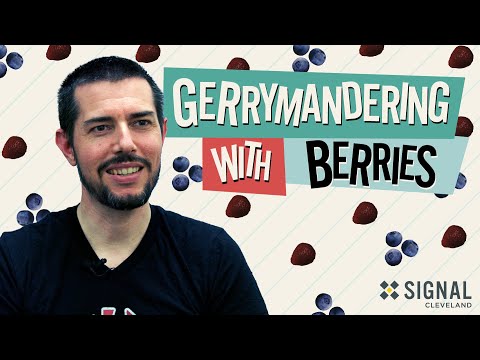Tired of thinking about politics as Democrats vs. Republicans? A local board game designer challenges people to choose different political identities: blueberries and strawberries.
Berrymandering – a play on “gerrymandering” – is a board game that teaches players to draw boundaries using cake slices to gain power and influence over the fictional Cakeland. By taking turns cutting and eating cake, players can start to understand how politicians often group voters – or, in game play, berries – for an edge over the competition.
“Ultimately, what we want to inspire is this ability for the strawberries and the blueberries – two different groups – to come together and find consensus,” Eliot Aretskin-Hariton, one of the designers, told Signal Cleveland. “We’re really strongest when we work together, not when we fight each other.”
Aretskin-Hariton is an engineer by day and a board game designer by night. He co-created Berrymandering with Justin Gray, who is also from Ohio. Since creating the game, Aretskin-Hariton said he’s seen players of all ages take something from it.
“There’s a fun factor, and there is an ability for students to retain more of what they learned whether they won or they lost,” he said.
For Aretskin-Hairton, it’s not about who wins, it’s about what players take away from the game. Regardless of which berry you choose, the game asks people to think twice about how politicians have often used gerrymandering to stack the odds in their favor.
Signal Cleveland sat down with Aretskin-Hariton to learn more about how gerrymandering inspired a game about berries and cake.
The interview has been edited for brevity and clarity.
Q: Talk to me about Berrymandering. Where did the idea come from?
The idea of Berrymandering came from my obsession with two things: cooking and math. I thought to myself, “Hey, I could make a board game out of this.” And so, that embarked on a year-long process of trying things, failing, trying again and finally coming up with the version of the game that we’ve made today.

Q: How does this game relate to gerrymandering?
In this game, you are playing either as strawberries or blueberries, and you are going to be cutting cake and attempting to earn candles. Whoever has the most candles at the end of the game is declared the new ruler of Cakeland. The game represents gerrymandering through the competition of these two berries.
When you’re playing with two players, it’s easy to see that it’s a very challenging game. If you’re playing the solo player version, where you get to cut and choose everything, it’s very easy to see how you can win and how your opponent – who just gets to sit there and doesn’t get to make any choices – might feel pretty bad and might not really want to play with you again. That kind of difference represents the current state of what’s happening here in Ohio.
Q: What is the process for making a board game?
I was inspired by news reports, videos and papers that I had read. I had to have some idea of how that could be turned into a set of rules. Once you have a set of rules, you can play test with your friends, and you can see, do they find it fun?
From that point, you want to identify a manufacturer, or go out to crowdfunding and raise some money and then identify a manufacturer. And we’ve done that through The Game Crafter, which is a U.S.-based manufacturing company that will do one or two copies of your game. To do larger production runs, we typically contract out of the country. These giant wooden versions, I make those myself in the basement.

Q: Why teach gerrymandering through a board game?
For me, it’s the involvement factor. There’s a fun factor, and there is an ability for students to retain more of what they learned whether they won or they lost. But they’re going to come back next time, and they’re going to do better.
We want to include classroom content so that teachers in grade school and in high school can take this game out of the box and run an hour-long classroom lesson on it as part of that process. We need to find a teacher educator who is going to be able to make that content for us.
Q: How does it make you feel to see kids – or anybody – enjoying the game?
It feels really great watching people play the game at this point. We’ve taken it to many board game conferences. We’ve seen people of all ages sit down and play this game, and a lot of the time, at first, they’re curious. They think the rules are so simple, they think the strategy is simple. And then as they start playing, they start to realize that there’s a huge amount of nuance that they weren’t expecting and a whole bunch of strategy that they also weren’t expecting. Seeing people go through that learning experience has been really inspiring for me.
Think you have what it takes to rule Cakeland? You can order one online or buy in store from Recess Games, 26636 Brookpark Rd Ext., North Olmsted.






